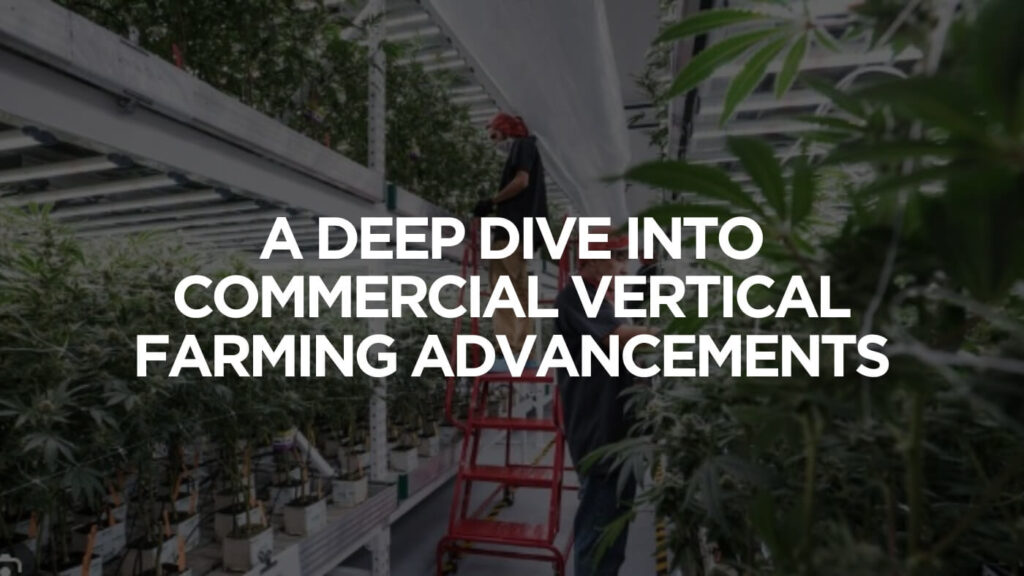Estimated reading time: 9 minutes
Table of contents
- What Is Commercial Vertical Farming?
- Benefits Of Commercial Vertical Farming
- The Cons Of Commercial Vertical Farming
- Types of Vertical Farming Systems
- Catalyst BC Vertical Farming Consultants
- Final Words
- Additional Resources
- Consulting Services For Cannabis, Hemp, Psilocybin, and Natural Medicine
- Testimonials and Public Relations
- Latest Articles
- Explore Our Articles
- Free Ebook – Start Your Own Legal Cannabis Business
In an era where space is limited and environmental sustainability is vital, commercial vertical farming advancements offer a promising solution for cannabis cultivation businesses. This cutting-edge approach allows cultivators to optimize space and resources to grow an abundance of fresh products.
Whether you’re an experienced farmer looking for ways to enhance your crops or an entrepreneur exploring the opportunities of this market, investing in commercial vertical farming technology is an efficient method to achieve your business goals.
In this post, we’ll dive into recent commercial vertical farming advancements, and explore its challenges, advantages, and disadvantages. We’ll also discuss different vertical farming systems, and how they can revolutionize your cannabis cultivation business.
What Is Commercial Vertical Farming?
Advancements in commercial vertical farming is a game-changing agricultural method that has been used for some time across various sectors and has recently found its way into the cannabis industry as well.
Vertical farming involves growing cannabis plants on stacked shelves, while in conventional agriculture, farmers grow produce horizontally in large swathes of land. Using height and stacked layers, allows the operation to grow plants on top of each other to produce more products while making the most of the space.
There are two main methods for vertical farming, true vertical and stacked vertical:
Stacked Vertical
Stacked vertical is the common approach to commercial vertical farming. In this method, the plants are grown in stacked shelves or racks, using hydroponic or aeroponic systems, and automation technologies to create the optimal growing condition.
True Vertical
The true vertical is a specialized approach to commercial vertical farming in which cultivators use PVC lines called “canvas” to grow plants. Using these pipes, farmers can produce corps on the side of columns in addition to the vertical layers.
Benefits Of Commercial Vertical Farming
Advancements in commercial vertical farming have gained significant attention in the cannabis industry, pushing the boundaries to grow more and better crops. Here are the advantages of this method and how Catalyst BC’s vertical farming consultant can help enhance your cannabis cultivation operation:
Space Optimization
The primary advantage of vertical farming is its ability to make the most of limited space. By utilizing height and vertical space, commercial vertical farming helps farmers maximize their cultivation capacity.
Vertical systems allow for plants to be stacked vertically, increasing the number of plants that can be grown within a given footprint. This can be particularly advantageous for businesses located in urban areas where land is often scarce or expensive.
Increased Yields
Implementing vertical farming systems allows cultivators to grow cannabis plants in different layers, offering ideal exposure to light on all plant surfaces. This promotes uniform growth and decreases shading issues.
In addition, the closed environment of this system provides cultivators with precise control over temperature, humidity, and nutrient delivery, offering perfect conditions for plant growth. As a result, commercial vertical farming helps produce more crops per square foot than traditional horizontal methods.
Resource Efficiency
One of the primary aims of vertical farming is to reduce resource use. With efficient management of environmental factors, this approach allows cultivators to reduce water usage.
Moreover, vertical farms typically use special LED lighting systems that save energy and are made to match the specific light needs of cannabis plants. The controlled environment also helps to decrease the amount of pesticides and herbicides required, resulting in more sustainable and eco-friendly growth.
Year-Round Production
Commercial vertical farming is the practice of growing cannabis indoors using shelves and artificial lighting. This allows operations to produce plants all year long, regardless of the changing seasons.
In this system, farmers have full control over the ecosystem climate inside the shelves where plants grow. This helps provide consistent cultivation conditions, irrespective of the temperature or amount of daylight outside.
As a result, cultivators can keep a steady flow of high-quality cannabis products and enhance customers’ satisfaction, and profit.
Reduced Labor And Automation
As an advanced approach to farming, commercial vertical farming often employs cutting-edge automation technologies, including robotic arms, automatic nutrient delivery, and climate control systems.
Utilizing these technologies streamline the cultivation process, and reduces the workload. This results in a reduced cost of hiring workers and lowering the possibility of human error.
Moreover, automation systems allow cultivators to monitor and control the plants’ environment from a distance, enhancing cannabis growth and minimizing the likelihood of issues occurring.
The Cons Of Commercial Vertical Farming
As with any farming approach, commercial vertical farming also presents challenges and limitations that should be considered for a successful implementation. Here are some of the drawbacks associated with this method of farming:
High Initial Investment
Commercial vertical farming is a profitable and cost-effective approach to cultivating cannabis. However, it requires a considerable upfront investment to cover costs associated with the infrastructures, equipment, and technologies.
The initial setup cost can be further increased, considering the expenses involved in maintaining optimal climate conditions, acquiring suitable lighting, implementing irrigation methods, and incorporating automation. These costs can make it difficult for small-scale operations with limited money to implement this method.
Energy Consumption
Commercial vertical farming relies heavily on artificial LED lighting systems. These lights provide the appropriate light spectrum to help plants grow. While LED lights are an improvement in energy consumption, vertical farms still consume a substantial amount of energy.
Using lighting, climate control systems, pumps, and other equipment consumes energy, leading to increased expenses and negative environmental impact.
Technical Expertise Requirements
To operate a commercial vertical farm successfully, businesses need to have a specialized team with in-depth knowledge and skills in farming methods. Cultivators must possess expertise in areas such as crop cultivation, irrigation, nutrient supply, and climate regulation.
Moreover, it is necessary to monitor and adjust the farm continuously to ensure it remains in optimal conditions. This requires well-trained employees to handle daily tasks, which can add to labor costs.
Types of Vertical Farming Systems
Advancements in commercial vertical farming systems accommodate multiple cultivation options, each offering unique advantages and challenges. Catalyst BC consultants can help analyze your cultivation business requirements and choose the optimal system.
Hydroponic Systems
Hydroponic systems leveraging vertical farming technology rely on nutrient-infused water to grow plants without soil. Using technologies like pumps, timers, and sensors, the system continuously circulates or delivers nutrient solutions to plant roots. Systems such as nutrient film technique (NFT) or deep water culture (DWC) integrate with vertical farming racks, allowing cannabis plants to grow in compact, stacked formations. LED lighting mimics sunlight, providing customized light cycles for each growth stage. This efficient setup minimizes water and fertilizer waste while producing consistent yields, making hydroponics a cornerstone of scalable vertical farming operations.
Subtypes:
- Nutrient Film Technique (NFT): A thin layer of water flows over the roots in channels.
- Deep Water Culture (DWC): Roots are submerged in aerated nutrient water.
- Ebb and Flow: Plants are periodically flooded with nutrient water that then drains away.
- Drip Systems: Nutrients are delivered to individual plants via emitters.
Pros:
- Efficient nutrient use.
- Reduced water consumption (up to 90% less than soil-based farming).
- Faster growth due to optimized nutrient delivery.
- Space-saving for high-density planting.
Cons:
- High initial costs for infrastructure.
- Susceptibility to system failures.
- Requires expertise to manage pH, nutrients, and water quality.
Best For: Operations with limited space and a focus on precision-controlled cultivation.
Aeroponic Systems
In aeroponic systems, plants are suspended in a closed or semi-closed environment with their roots exposed to air. Nutrient-rich water is delivered in the form of a fine mist directly to the roots at precise intervals. This system leverages advanced sensors and automation to monitor root conditions, ensuring plants receive optimal oxygen, nutrients, and moisture. LED lighting systems provide tailored spectrums to enhance photosynthesis while minimizing energy consumption. Aeroponic technology works seamlessly with vertical farming by utilizing modular towers or stacked layers, maximizing growth potential in limited spaces while conserving water and resources.
Pros:
- Maximizes oxygen exposure for roots, enhancing nutrient uptake.
- Highly water-efficient.
- Promotes rapid growth and higher yields.
Cons:
- Expensive setup and maintenance.
- Requires constant monitoring to prevent root dehydration.
- Vulnerable to environmental instability due to exposed roots.
Best For: High-tech farms prioritizing water efficiency and maximum yield quality.
Aquaponic Systems
Aquaponic systems combine aquaculture (raising fish) and hydroponics in a closed-loop ecosystem. Fish waste, converted by beneficial bacteria into plant-usable nutrients, serves as a natural fertilizer for crops. In vertical farming, this system integrates layers of growing trays with a shared water reservoir supporting fish below. Automated filtration, oxygenation, and circulation ensure both plant and fish health. The synergy of aquaponics with vertical farming technology maximizes sustainability, as it reduces chemical inputs, recycles water efficiently, and provides dual outputs of crops and fish, appealing to eco-conscious growers.
Pros:
- Fully sustainable, eco-friendly system.
- Eliminates the need for chemical fertilizers.
- Produces two revenue streams: crops and fish.
Cons:
- Complex to set up and maintain.
- Balancing fish health and plant needs requires expertise.
- Limited scalability for high-volume cannabis production.
Best For: Eco-conscious operations seeking sustainability and diversification.
Catalyst BC Vertical Farming Consultants
If you are considering starting a cannabis vertical farming technology or looking to optimize your existing cannabis cultivation operation a consultant can offer support and guidance.
But What Is A Cannabis Consultant, you may ask. In short, cannabis consultants are professionals with extensive knowledge and expertise in the cannabis industry. They possess a deep understanding of the different Types Of Cannabis Business Strategies and can help enterprises in various sectors including cultivation, production, distribution, and retail.
Catalyst BC are experts in various farming methods including commercial vertical farming technology. We stay up to date with the most recent trends, technologies, and optimal strategies, enabling us to offer you the very best and cutting-edge solutions. We understand that every operation is unique, with its problems and objectives. That’s why we work closely with you to understand your specific needs and goals and develop tailored plans for all types of farms, from small-scale urban farms to large commercial cannabis cultivation operations.
Final Words
Commercial vertical farming presents a promising solution to the challenges faced by traditional cannabis cultivation methods. By maximizing space use, conserving resources, and providing year-round produce, innovations in vertical farming have truly elevated the way we grow and access cannabis.
This approach can easily be modified to operate in different settings and meet the needs of various markets as well so that farmers can adopt various systems including hydroponic systems, aeroponic systems, and aquaponics systems to achieve their desired results.
Although advancements in commercial vertical farming technology present numerous advantages, it is crucial to recognize the challenges it faces. This involves significant upfront expenses, considerable energy consumption, and the requirement for specialized expertise.
That said, as the cannabis industry moves forward, advancements in technology and increased production capacity will hopefully eliminate the obstacles, making vertical farming more accessible and profitable.
Win in the green frontier. Contact Catalyst BC and our professional consultants help you get started!
Additional Resources
Consulting Services For Cannabis, Hemp, Psilocybin, and Natural Medicine
- Consulting Services Overview
- Business Strategy
- Financial Planning
- Cannabis, Hemp, Psilocybin, & Natural Medicine Licensing and Applications
- Facility Design
- StartUp Support
- Genetic Development
- Business Turnaround
- Operational Optimization
- Vertical Farming
- Controlled Environmental Agriculture (CEA)
- State and Country Services Directory
- Blog
- Home
Testimonials and Public Relations
Latest Articles
- Cannabis 280E Compliance and COGS Optimization Expert StrategiesThe cannabis industry operates under a unique federal tax burden imposed by Internal Revenue Code (IRC) §280E. While state legalization has flourished, this provision, which denies deductions for ordinary business expenses of trades dealing in controlled substances, remains the single greatest threat to cannabis profitability.
- Owner’s Rep for Cannabis Dispensary Buildout: Expert Compliance & Project ManagementNavigating the highly-regulated world of a cannabis dispensary buildout requires specialized expertise beyond standard construction. The complexity of securing a final operating license, controlling costs, and preventing opening delays for a cannabis dispensary hinges on professional guidance. This is why securing an experienced Owner’s Rep for Cannabis Dispensary Buildout is a critical first step.
- The Indispensable Owner’s Rep for Cannabis Cultivation Facility Buildout: Expert Project Management to Prevent Cost OverrunsIn this high-stakes arena, the Owner’s Rep for Cannabis Cultivation Facility buildout is the crucial strategic partner. They are the expert professional who ensures the owner’s vision is translated into a successful, operational, and profitable reality.
- Cannabis Dispensary Compliance: Training, Inventory & ProfitabilityIn today’s regulated cannabis market, cannabis dispensary compliance is not optional—it is the foundation of a sustainable and profitable retail business. Every dispensary, from boutique shops to multi-state operators, must follow strict dispensary regulatory compliance standards, maintain accurate cannabis inventory management systems, and invest in ongoing cannabis dispensary training programs.
- Beyond Compliance: Implementing a Cannabis Dispensary Secret Shopper ProgramAs a cannabis retail owner, you operate in a high-stakes environment where federal prohibition meets state-regulated commerce. Your retail floor is not just a sales hub—it’s a constant target for mandatory inspection and the front line for brand differentiation. The most critical tool for navigating this complex reality is the professional, recurring Cannabis Secret Shopper program.
- Architects of the Cannabis Industry: What Defines An Expert Canna Consultant?An expert Canna Consultant is the strategic architect and operational engineer of a cannabis venture. They are specialized cannabis industry consultants who translate ambiguous legislation into profitable business processes.
Explore Our Articles
cannabis applications Cannabis Bar Cannabis Business Optmization cannabis careers Cannabis Compliance Cannabis Consumption Cannabis Consumption Bar Cannabis Inventory Management Systems Cannabis Investors cannabis jobs Cannabis Legalization cannabis licensing Cannabis Lounge cannabis marketing Cannabis Operational Procedures cannabis outreach Cannabis Regulations Cannabis Security Cannabis Software Cannabis Startup Cannabis Supply Chain Cannabis Technology Colorado controlled environment agriculture Cultivation cultivation facility Dispensary Design facility design Financial Planning HVAC HVACD Iowa Kansas Legal Update Legislation Medical Cannabis Minnesota Natural Medicine Nebraska New York Odor Control Oregon Psilocybin Psychedelics Recreational Cannabis
Free Ebook – Start Your Own Legal Cannabis Business








